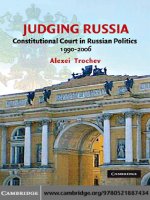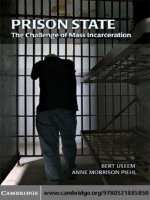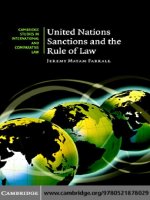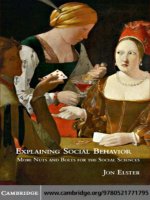0521853044 cambridge university press god vs the gavel religion and the rule of law jun 2005
Bạn đang xem bản rút gọn của tài liệu. Xem và tải ngay bản đầy đủ của tài liệu tại đây (3.18 MB, 430 trang )
P1: JZZ
0521853044agg.xml
CB900/Hamilton
0 521 85304 4
This page intentionally left blank
ii
April 15, 2005
21:3
P1: JZZ
0521853044agg.xml
CB900/Hamilton
0 521 85304 4
April 15, 2005
GOD VS. THE GAVEL: RELIGION AND THE RULE OF LAW
God vs. the Gavel: Religion and the Rule of Law challenges the pervasive assumption that all religious conduct deserves constitutional protection. While
religious conduct provides many benefits to society, it is not always benign.
The thesis of the book is that anyone who harms another person should be
governed by the laws that govern everyone else – and truth be told, religion
is capable of great harm.
This may not sound like a radical proposition, but it has been under assault since the 1960s. The majority of academics and many religious organizations would construct a fortress around religious conduct that would make
it extremely difficult to prosecute child abuse by clergy, medical neglect of
children by faith healers, and other socially intolerable behaviors. This book
intends to change the course of the public debate over religion by bringing
to the public’s attention the tactics of religious entities to avoid the law and
therefore harm others. God vs. the Gavel will bring much-needed balance to
the contemporary, heated debate about religion and its role in society.
Marci A. Hamilton is an internationally recognized constitutional authority
specializing in church/state relations. She is a leading national expert on
the Religious Freedom Restoration Act, which she successfully challenged
before the U.S. Supreme Court, and is involved in cutting-edge First Amendment litigation involving clergy abuse (on behalf of victims) and religious
land use (Religious Land Use and Institutionalized Persons Act).
i
21:3
P1: JZZ
0521853044agg.xml
CB900/Hamilton
0 521 85304 4
ii
April 15, 2005
21:3
P1: JZZ
0521853044agg.xml
CB900/Hamilton
0 521 85304 4
GOD vs.
THE GAVEL
April 15, 2005
RELIGION AND THE
RULE OF LAW
MARCI A. HAMILTON
FOREWORD BY THE HON. EDWARD R.
BECKER
iii
21:3
Cambridge, New York, Melbourne, Madrid, Cape Town, Singapore, São Paulo
Cambridge University Press
The Edinburgh Building, Cambridge , UK
Published in the United States of America by Cambridge University Press, New York
www.cambridge.org
Information on this title: www.cambridge.org/9780521853040
© Marci A. Hamilton 2005
This publication is in copyright. Subject to statutory exception and to the provision of
relevant collective licensing agreements, no reproduction of any part may take place
without the written permission of Cambridge University Press.
First published in print format 2005
-
-
---- eBook (EBL)
--- eBook (EBL)
-
-
---- hardback
--- hardback
Cambridge University Press has no responsibility for the persistence or accuracy of s
for external or third-party internet websites referred to in this publication, and does not
guarantee that any content on such websites is, or will remain, accurate or appropriate.
P1: JZZ
0521853044agg.xml
CB900/Hamilton
0 521 85304 4
This book is dedicated to
my beloved Peter, Will, and Alexandra,
whose loving encouragement has been a godsend.
v
April 15, 2005
21:3
P1: JZZ
0521853044agg.xml
CB900/Hamilton
0 521 85304 4
vi
April 15, 2005
21:3
P1: JZZ
0521853044agg.xml
CB900/Hamilton
0 521 85304 4
April 15, 2005
CONTENTS
Acknowledgments / ix
Foreword, by the Hon. Edward R. Becker / xi
part one. why the law must govern religious entities
1
2
3
4
5
6
7
The Problem / 3
Children / 12
Marriage / 50
Religious Land Use and Residential Neighborhoods / 78
Schools / 111
The Prisons and the Military / 141
Discrimination / 173
part two. the history and doctrine behind the rule that
subjects religious entities to duly enacted laws
8 Boerne v. Flores: The Case That Fully Restored the Rule of
Law for Religious Entities / 203
9 The Decline of the Special Treatment of Religious Entities
and the Rise of the No-Harm Rule / 238
10 The Path to the Public Good / 273
Epilogue / 306
Notes / 313
Index / 399
vii
21:3
P1: JZZ
0521853044agg.xml
CB900/Hamilton
0 521 85304 4
viii
April 15, 2005
21:3
P1: JZZ
0521853044agg.xml
CB900/Hamilton
0 521 85304 4
April 15, 2005
ACKNOWLEDGMENTS
This book could not have been written without the assistance of my
chief research assistant and third-year law student at Benjamin N.
Cardozo School of Law, Rachel Steamer. She did a tremendous job,
and I will be forever indebted to her for her extraordinary research skills,
work ethic, and excellent judgment. I also thank Research Assistants
Jodi Erickson, Rachel Lavery, Andrew Kopelman, Leo Mikityanskiy, and
Philip Wellner, for their hard work and research assistance. My good
friend, Kerry Ledbetter, provided invaluable line editing.
I am also indebted to John Berger, who is a brilliant editor at Cambridge
University Press, and who helped me immeasurably to marshal ten years
of scholarly work and practical experience into a single coherent project
for a more general audience. I am very grateful to my agent, Karen Zahler,
who helped me tremendously to refine my thesis and then to find the
right niche for it. Sr. Karol Jackowski, who is the most spiritual person I
know, was a much-needed source of inspiration and friend through it all.
Significant portions of Chapter 9 were previously published as part of
the Foundations of Church Autonomy Symposium at the Brigham Young
University School of Law. See Marci A. Hamilton, Religious Institutions,
the No-Harm Doctrine, and the Public Good, 2004 B.Y.U. L. Rev. 1099
(2004). I am grateful to the participants of the symposium for their comments and for the excellent editorial work of BYU student editor Brigham
Cannon and others.
ix
21:3
P1: JZZ
0521853044agg.xml
CB900/Hamilton
0 521 85304 4
April 15, 2005
x / ACKNOWLEDGMENTS
Thanks are also due to the Benjamin N. Cardozo School of Law,
Yeshiva University, for a summer grant and sabbatical in 2004, which
made it possible for me to write God vs. the Gavel, and especially to
Deans Paul Verkuil and David Rudenstine for their unflagging support
for my admittedly unorthodox scholarship. Gratitude is also due to Tom
Lee for his generous philanthropy that supports my chair at Cardozo
School of Law, the Paul R. Verkuil Chair in Public Law. In addition, the
Princeton Theological Seminary, where I was a visiting scholar during the
fall of 2004, provided important research resources as well as a welcome
atmosphere of open inquiry about religion and theology.
Judge Edward R. Becker, who provided the foreword, deserves lifelong
gratitude. He has been the sort of mentor many people never know. He
is in every sense of the term a mensch and a blessing on all those who
know him.
The list of people who have taught me what I needed to know to write
this book is endless, but I must express my gratitude to Jeffrey Anderson,
who was helping clergy abuse victims long before the rest of us knew it
was a problem, for his wisdom about clergy abuse; Ellen Mugmon and
Rita Swan, for opening my eyes to the plight of children at the hands
of some religious believers; Barbara Blaine and David Clohessy, of the
Survivors Network of those Abused by Priests (SNAP), for their tireless
dedication to the victims of childhood sexual abuse by clergy; Len Hill,
who started the League of Residential Neigbhorhood Advocates, for his
courage and dedication in standing up for residential neighborhoods
negatively affected by ambitious religious building projects; Sarah Hart,
Pam Sargent, and Todd Marti, who educated me about the abuses of
religious privileges in the prisons; and the Mayor of Boerne, Texas, the
Rev. Patrick Heath, whose courage as a Methodist minister in fighting
the Religious Freedom Restoration Act all the way up to the Supreme
Court inspires me still.
But no one deserves more credit than my husband, Peter Kuzma. He
has read chapters when he needed to sleep, provided the right criticism
when it was needed most (and even when I did not want to hear it), and set
an example of a believer who will not tolerate the status quo if a religious
entity has overstepped its bounds. He is a devoted Roman Catholic who is
determined to do everything he can to make the church safe for children.
His integrity, his belief in the truth, and his loving support for this book
literally made it happen.
21:3
P1: JZZ
0521853044agg.xml
CB900/Hamilton
0 521 85304 4
April 15, 2005
FOREWORD
The role of religion in a free society, once a subject of benign and lofty
discourse, has become a raging controversy in both the private and public arenas. While few in America challenge the multifarious benefits of
religion to the individual believer and to society as a whole, there are
sharply divergent views as to the extent to which notions of religious liberty immunize religious conduct from sanction when it interferes with
public health, safety, and welfare.
In recent years, religious entities, often with the assistance of legislatures and courts, have advocated a presumptive constitutional right to
avoid the law pursuant to the federal and state free exercise of religion
guarantees, arguing that the First Amendment, the Due Process Clause,
and separation of powers render them immune from some legal requirements and precepts. Opponents of these initiatives have responded that
this approach is at odds with American culture and legal tradition.
In this volume, Professor Marci Hamilton, one of the nation’s leading
legal scholars and one of the premier authorities on the Constitution’s
Religion Clauses, tackles these issues in depth and with gusto. Her dominant theme is that the temptation to treat religion as an unalloyed good
is a belief one can embrace only at one’s peril. Building upon her already prolific body of work, she proceeds from the baseline of the “noharm principle” – that no person or entity can act in ways that harm others
without consequence – which she demonstrates was widely shared by the
Framers’ generation. After establishing, with impressive documentation,
xi
21:3
P1: JZZ
0521853044agg.xml
CB900/Hamilton
0 521 85304 4
April 15, 2005
xii / FOREWORD
that, despite their generally beneficent effect, religious entities can be
responsible for many harms, e.g., lethal medical neglect of children,
childhood sexual abuse, the takeover of neighboring property owners’
rights under the zoning laws, and the undermining of laws against discrimination, she forcefully argues that the burden rests on the religious
believers demanding exemption from a law to prove that the conduct
sought to be immunized is not harmful to the society and individuals
within it. Referencing the precept of Employment Division v. Smith that
“the [correct] reading [of the Free Exercise Clause] is . . . an individual’s
religious beliefs do not excuse him from compliance with an otherwise
valid law prohibiting conduct that the State is free to regulate,” Professor Hamilton engages the scholarship of Professor Laycock and Professor
(now Judge) McConnell and that of others who have criticized this holding. She argues that these scholars have misconstrued the jurisprudence
of the Religion Clauses and that their defense of the Religious Freedom
Restoration Act (overruled by City of Boerne v. Flores) and the Religious
Land Use and Institutionalized Persons Act (RLUIPA) is flawed.
Whatever the reader’s take on these issues may be, he or she will be
edified by Professor Hamilton’s exegesis of the history, jurisprudence, and
policy considerations that inform the debate. This is a truly important,
if provocative work, which is essential reading for anyone who wishes to
delve beneath the surface of the contemporary battle over religion and
values.
The Hon. Edward R. Becker
United States Court of Appeals
for the Third Circuit
21:3
P1: JZZ
0521853044agg.xml
CB900/Hamilton
0 521 85304 4
GOD VS. THE GAVEL: RELIGION AND THE RULE OF LAW
xiii
April 15, 2005
21:3
P1: JZZ
0521853044agg.xml
CB900/Hamilton
0 521 85304 4
xiv
April 15, 2005
21:3
P1: JZZ
0521853044agg1.xml
CB900/Hamilton
0 521 85304 4
PART ONE
WHY THE LAW MUST
GOVERN RELIGIOUS
ENTITIES
1
April 15, 2005
21:6
P1: JZZ
0521853044agg1.xml
CB900/Hamilton
0 521 85304 4
2
April 15, 2005
21:6
P1: JZZ
0521853044agg1.xml
CB900/Hamilton
0 521 85304 4
April 15, 2005
1
THE PROBLEM
The United States has a romantic attitude toward religious individuals and
institutions, as though they are always doing what is right. As one scholar
has quipped: “There is a long history in this country of religion being
reduced to Sunday school morality in service of the common good.”1
Were religious institutions and individuals always beneficial to the public,
this book would not need to be written, and they would not need to
be deterred from criminal or tortious behavior. Religious liberty could
be absolute. The unrealistic belief that religion is always for the good,
however, is a hazardous myth. The purpose of this book is to persuade
Americans to take off the rose-colored glasses and to come to terms with
the necessity of making religious individuals and institutions accountable
to the law so that they do not harm others.
3
21:6
P1: JZZ
0521853044agg1.xml
CB900/Hamilton
0 521 85304 4
April 15, 2005
4 / GOD VS. THE GAVEL
Without a doubt many religious entities provide important benefits to
society. Catholic Charities, the United Jewish Communities, and numerous other mission organizations do wonderfully good works. They feed
and house the poor, counsel the addicted, minister to the downtrodden,
and educate on a large scale. In 2003, religious organizations received
nearly 40 percent of all charitable contributions in the United States,
which translates into over $86 billion to spend on good deeds.2 In 2005,
religious relief organizations have been indispensable in helping the millions of Indonesian tsunami victims. It is nearly impossible to imagine
how the United States or the world could function without the services
of these groups. There would be a severe deficit in the public’s welfare if
they were to close their doors.
Religious belief and ritual also can be a powerful source of inspiration,
comfort, and healing, as the hard sciences now acknowledge.3 It can
ease the suffering caused by disease, death of a loved one, and the other
catastrophes of human life. I know this firsthand as I have turned to prayer
many times in my life.
Religious beliefs and speech are also a crucial source of critique of
the state, and at their best bring the human drive to power into perspective. Religion can be a liberating force. For example, believers challenged slavery in the United States as early as the 18th century, built the
slave-liberating Underground Railroad in the late 19th century, and then
led the civil rights marches in the 1960s. It is an undeniably powerful
force.
No country, of course, can afford to ignore religion’s force on the people, as China is learning with its unsuccessful attempts to eliminate Falun
Gong and Christianity.4 In today’s China, burgeoning religious pluralism has translated into increasingly repressive government policies. The
2004 Report of the U.S. Commission on International Religious Freedom
explained the problem: “The Chinese government’s campaign against
evil cults has reportedly expanded beyond the Falun Gong and similar
groups to those who are not part of the officially sanctioned religious
organizations. This includes both newer and long-established Protestant
and Catholic churches and leaders who, for various reasons, refuse to
register with the government. Religious leaders have been imprisoned
and followers detained and fined for ‘cultist activity.’”5
21:6
P1: JZZ
0521853044agg1.xml
CB900/Hamilton
0 521 85304 4
April 15, 2005
THE PROBLEM / 5
There could not be a gentler religion than the Falun Gong, but its
existence has threatened the governing powers in China. Three values –
truth, compassion, and tolerance – form the backbone of Falun Gong’s
philosophy. Since July of 1999, communist officials, most notably party
head Jiang Zemin, have campaigned to “eradicate” Falun Gong and any
support for it among the Chinese people or foreign governments. According to the Falun Dafa Information Center, as of November 2002, over
500 have died from maltreatment in custody. Sources inside China, however, place the number of deaths in the thousands. Hundreds of thousands more suffer relentless abuse in prisons, forced labor camps, and
brainwashing facilities.6 Chinese authorities have also waged an abolition campaign against Christian organizations such as the Three Class
Servants Church, whose members are said to number in the millions. In
2004, a campaign of arrests, beatings, and extortion of family members
resulted in the disappearances and deaths of both bishops and laypersons
alike.7 China’s relentless persecution of believers has led to sanctions
from the United States and other countries.8
Communism did not survive in Eastern Europe and has not led to true
freedom for the people in other countries in part because of its inability to incorporate religious belief into its social structure.9 Russia tried
to suppress the Orthodox Church under communism, but could not
stamp it out. Church members escaped to the catacombs, where they
created an underground church and developed an elaborately encrypted
method of communication. Despite the imprisonment and execution of
church leaders in Soviet Gulags and concentration camps, the secret
church survived and was shepherded through the Soviet era by priests
and believers who continued to perform consecrations and religious
services.10 Religion simply cannot be denied.
Despite these many virtues, a good deal of religious conduct is not
beneficial. Herein lies the problem – some religious conduct deserves
freedom and some requires limitation. Ridding society of religion is no
answer, and therefore the United States must grapple with religion at its
worst as well as its best. God vs. the Gavel argues that the right balance is
achieved by subjecting entities to the rule of law – unless they can prove
that exempting them will cause no harm to others. There is nothing in this
book that can take away these virtues, and no intention to do so. There is
21:6
P1: JZZ
0521853044agg1.xml
CB900/Hamilton
0 521 85304 4
April 15, 2005
6 / GOD VS. THE GAVEL
another side, though. Religion’s force can be just another iteration of the
drive to power. As such, it can wreak horrible wrongs on individuals and
society. Sometimes the fight goes on for centuries, as it has in Ireland between Catholics and Protestants.11 Christians led the horror-filled years of
the Medieval Inquisition and the Spanish Inquisition.12 Britain’s Queen
Mary and Queen Elizabeth executed or exiled scores of “infidels” who
did not profess to the queen’s religion.13 The Hindu majority in India and
the Muslim majority in Pakistan have been battling over the Kashmir
border region since the British partition in 1947.14 Israel has been in conflict with Palestinians over the West Bank for over 50 years. In the United
States, the Salem witches were hung or, in one man’s case, crushed to
death, for religious reasons.15 In this era, Islamic radicals, many of whom
are part of a fundamentalist movement that was initiated in 1928,16 are
waging a war of terror worldwide. To this day, there are male fundamentalist polygamists in secret enclaves who enslave women and sexually and
physically abuse their children.17 Faith-healing parents let children die of
agonizing deaths from easily treated medical conditions like diabetes.18
Thousands of children have been sexually abused by clergy in many denominations. And this is only a sampling of the numerous religiously
motivated actions that harm others.
Despite such facts, there has been a temptation in the United States
to treat religion as an unalloyed good. It is a belief one can embrace only
at one’s peril. There has been an increasingly strident chorus that the
United States has been secularized and that religion has lost its force in
the culture. Yale Law professor Stephen Carter’s widely read book, The
Culture of Disbelief: How American Law and Politics Trivialize Religious
Devotion,19 fed into this social drive. The book portrayed religion as a
diminishing influence in society. Ironically, the secularization thesis has
permitted organized religion to don the garb of the underdog, when in
fact its political power has been quite potent, even if usually behind the
scenes. Religion’s double role of downtrodden and politically powerful
was ironically transparent when in 1993 Senator Orrin Hatch justified
the Religious Freedom Restoration Act, which put religious individuals
and institutions in the position of being able to challenge every neutral,
generally applicable law in the country, by saying, “Government too
often views religion with deep skepticism and our popular culture too
often treats religious belief with contempt.”20
21:6
P1: JZZ
0521853044agg1.xml
CB900/Hamilton
0 521 85304 4
April 15, 2005
THE PROBLEM / 7
Indeed, the Culture of Disbelief and the viewpoint it fostered aided
religions in their lobbying efforts, because few would suspect that such
“weak” political actors could be as busy and as successful as they have been
in the legislative context. The truth is that the vast majority of Americans
are religious believers, church attendance is higher in the United States
than anywhere else in the world, higher than at any time in U.S. history,
and religious viewpoints fill the public square. While Americans were
reading Carter’s book and being convinced that the United States was
“trivializing” religion, thousands of children were being sexually abused
by clergy, with no one seemingly able to help them – not the press, not
the prosecutors, not their parents, and certainly not the churches. As
American society has sublimated the potential risks of religious entities,
it has sold out its most vulnerable.
The test of religious liberty that would fail to take into account this
other side of religion guarantees suffering. Religious entities have the
capacity for great good and great evil, and society is not duty bound by any
constitutional right to let them avoid duly enacted laws, especially where
their actions can harm others. To say that religious liberty must encompass
the right to harm others is to turn the First Amendment on its head.
Part One details some of the instances where religious entities have
harmed the public good and documents facts about religion that require
sunshine and public debate. Some will label it perverse, and others a
betrayal, but it is intended to be an education – one that is sorely needed
if true liberty for all is ever to be embraced. Nor is Part One intended to
be an argument for eradicating religion, as some might try to interpret it.
To the contrary, the impetus for this book lies in a belief in the depthless
good that religious entities can and do supply. But that belief is tempered
by my deep disappointment in learning the truth of what some religious
entities actually have done and continue to do. My rose-colored glasses
broke years ago.
From the ivory tower, it is easy to spin abstract arguments about the
high principle of protecting religious conduct. Read this:
Having engaged in my own weighing of the value of religious diversity
against the potential for anarchy and having determined that religious
diversity is highly valuable while the fear of anarchy is without basis
at this time in history, I would push the line to be drawn in these
21:6
P1: JZZ
0521853044agg1.xml
CB900/Hamilton
0 521 85304 4
April 15, 2005
8 / GOD VS. THE GAVEL
cases to the farthest extreme compatible with the viability of a living
democracy, which is to say that the exercise of religion should trump
most governmental regulation.21
I’m now embarrassed to say that I wrote that. If one’s theory of protecting
religious conduct is based on hypotheticals, ideals, and Sunday School,
as mine was, it is not difficult to concoct a theory of religious liberty that
permits religious conduct to sail above the law and the people. My views
have changed 180 degrees, because I have been educated and now know
the severe harm religious entities can cause. Most laws should govern
religious conduct, with the only exception being when the legislature
has determined that immunizing religious conduct is consistent with
public welfare, health, and safety.
In recent decades, religious entities have worked hard to immunize
their actions from the law, either by obtaining legislative exemptions
or by forcing the courts to invalidate any law substantially burdening
religious conduct that was not absolutely necessary. They have always
waved the banner of “religious liberty,” and few Americans have thought
to question them. What could be more important in a free society than
religious liberty? When the question is left in the abstract, it is hard
to think of anything more important. But when one operates from the
ground and knows the facts, the answer to the question is that there are
all sorts of interests that must trump religious conduct in a just and free
society – such as the interest in preventing childhood sexual abuse, or in
deterring terrorism, or in preserving private property rights. Every citizen
has at least as much right to be free from harm as the religious entity has
to be free from government regulation.
In effect, though never explicitly, religious entities have been lobbying
for the right to hurt others without consequences. That is a severe attack
on the rule of law, which is supposed to guarantee that no one becomes
a law unto himself. In a republican form of democracy like this one, the
laws are enacted to serve the larger public good, and no one should be
permitted to harm another person without account. True religious liberty
recognizes an absolute right of belief and, at the same time, society’s
necessary power to regulate religious conduct to serve the public good.
There are two legal tacks religious individuals and institutions (the
collective of which I will refer to as “religious entities”) have pursued
21:6
P1: JZZ
0521853044agg1.xml
CB900/Hamilton
0 521 85304 4
April 15, 2005
THE PROBLEM / 9
that have led to disastrous results: legislative exemption and/or constitutional – typically First Amendment – interpretation. The first is to put
pressure on the legislative process to obtain exemptions from generally
applicable laws. Sometimes they are asking for the right to follow their
religious beliefs. For example, the Christian Scientists have a longstanding campaign to exempt parents from having to provide their children
with medical treatment, which I will address in Chapter 2.
At other times religious entities ask for exemptions that go well beyond
their religiously motivated conduct to avoid liability for their misconduct.
For example, the Catholic Church worked hard to prevent clergy from
having to report child abuse (knowing as it did that many of its priests
were in fact abusing children) – even when a report would not violate
the confessional. Their religiously motivated conduct did not require the
protection, but their project of keeping secret widespread child sexual
abuse by its clergy did.
At other times, the exemptions requested are what I refer to as blind
exemptions. Groups of religious entities have persuaded legislatures to
grant them a presumptive right to trump all laws or an entire category
of law, on the theory that religious liberty demands freedom from the
law. Examples include the Religious Freedom Restoration Act of 1993, its
counterparts in the states, and the Religious Land Use and Institutionalized Persons Act of 2000 each of which will be discussed in more detail
in later chapters.
Too often, specific exemptions have been passed without the general
public – and sometimes the legislators – having any idea how the exemption would affect others. In a typical scenario, a religious group would
quietly approach a legislator (inside or outside the capitol), and the legislator would then slip the exemption into some bill involving a wholly
different subject. There would be no hearings, no public debate, and
there would be no in-depth reporting to unmask the dangers of freeing
religious entities from the law. Everyone who knew about it would go
home satisfied – the legislator because he had done a “good deed” that
day, and the religious entity, because it would avoid liability for its actions. Yet, the secrecy meant that the entities’ future victims had no idea
what was coming, as it permitted legislators to mimic the hear-no-evil,
see-no-evil, speak-no-evil monkeys. This was supposedly religious liberty,
American style. The results, documented in Part One, are not pretty.
21:6









